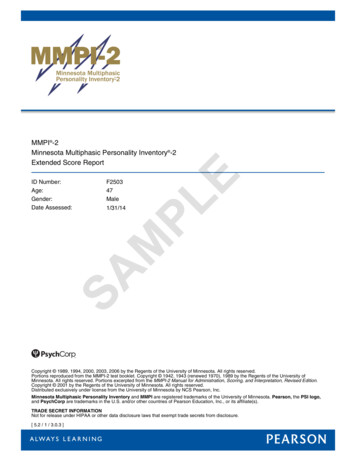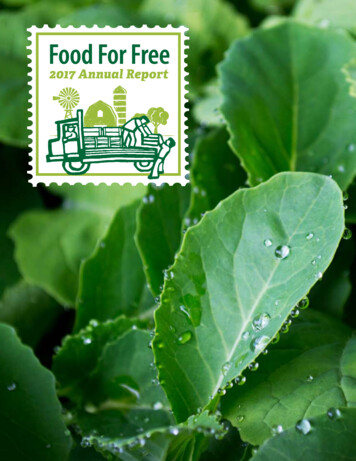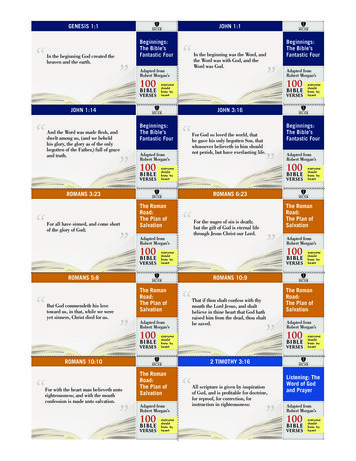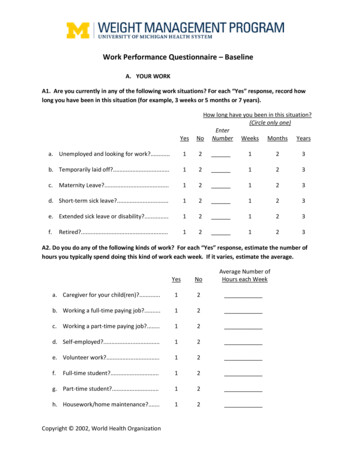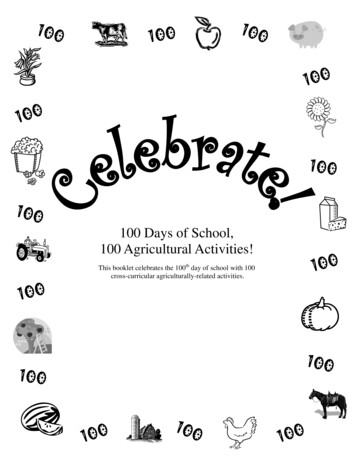
Transcription
10 01 0010 01 001 0010 0100100 Days of School,100 Agricultural Activities!10 010 0This booklet celebrates the 100th day of school with 100cross-curricular agriculturally-related activities.10 010 010 01 0010 0
Celebrate 100 Days of School100th Day festivities have been celebrated throughout schools since theschool year of 1981-1982. Lynn Taylor introduced the 100th Day of School ideain the Center for Innovation in Education newsletter. Early celebrations focusedon developing number sense for young children. Today, preschool childrenthrough elementary students celebrate their 100th Day of School with manycross-curricular activities. In keeping with tradition, Illinois Agriculture in theClassroom created this booklet with engaging, hands-on activities related to agriculture for students to do on the 100th Day of School.A visual key has been created and used with each activity to indicate its subjectarea. The topics include: hands-on, science, health and nutrition, reading, math,social studies, writing, and art.hands-onwritingsciencesocial studiesreadinghealth andnutritionartmath1
Activity Reference GuideSubject AreaActivity Number1, 5, 21, 33, 45, 51, 52, 57, 59, 76, 86, 94, 979, 16, 17, 19, 20, 41, 65, 934, 13, 37, 38, 85, 9614, 31, 34, 36, 44, 46, 62, 70, 77, 80, 82, 922, 3, 7, 8, 10, 15, 18, 22, 23, 40, 42, 48, 50, 54, 55, 69, 72, 73,74, 78, 81, 87, 89, 90, 91, 9924, 25, 26, 27, 29, 30, 32, 39, 56, 58, 60, 61, 63, 64, 66, 67, 68,71, 79, 886, 28, 47, 49, 53, 83, 84, 98, 10011, 12, 35, 43, 75, 952
12345Tallest, Free-Standing, Agriculturally Related StructureActivity:Set a timer for 5 minutes and tell students to build the tallest, free-standing, agriculturallyrelated structure they can think of using 100 Corn Packing Peanuts. After time is up, haveeach student share what they constructed and how it is related to agriculture. Measureeach structure and give the winner an ag-themed prize. Read the Corn Ag Mag.Agriculture is EverywhereActivity:Divide students into several groups. Tape a large piece of paper in the front of theroom. Students will look through magazines and newspapers to find people or itemsrelated to agriculture. As a class, find 100 items in all. Have students keep a class tallyon the board of how many items they add. Stop every few minutes and have studentscount the tally marks aloud and subtract the total from 100 to see how many more itemsthey need to find. Once there are a hundred items on the paper, talk about the objectsand how they relate to agriculture. Hang the finished piece outside the classroom to remind everyone that Agriculture is Everywhere!Feed SacksActivity:Refer to www.agintheclassroom.org under Lessons and Activities for ingredients andinstructions for Pork Feed Sacks. In a large bowl mix 100 items of each ingredient. Students can fill a plastic snack bag using the ingredients in the bowl to create their ownfeed sack. Read the Pork Ag Mag and discuss the different nutritional needs betweenhumans and pigs while your students enjoy their feed sack.Snack TimeActivity:Eating the right snacks throughout the day is very important for students’ nutrition.Have students come up with 100 different snacks that they would like to eat throughoutthe day. Compile one large list and have students categorize their snacks into healthyand non-healthy snacks. Have students compile a list of 100 nutritious snacks. Forsnack that day, provide apples as a nutritious snack and have students read the Horse AgMag. Discuss a horse’s eating habits and why they enjoy apples as a treat.100 Facts About AgricultureActivity:Challenge students to list 100 facts they know about agriculture. Then, prepare 100paper slips using a variety of colors. Have each student write a fact on a slip of paperand construct a paper chain. Hang the paper chain in the classroom to show off yourclass’s Ag knowledge.3
67891011Farm AnimalsActivity:On a piece of paper have each student list as many farm animals as they can in 100 seconds. Discuss the animals we raise in Illinois. Read the Beef, Pork and Poultry AgMag, and talk about the byproducts and how we use these animals.EstimateActivity:Ask students how much space 100 kernels of popcorn will take up in a glass jar. Markestimates with a marker. Pour in popcorn kernels and discuss the differences betweentheir estimates and the actual measurement. Ask students to share if their measurementswere greater than, less than, or equal to the actual measurement.EstimateActivity:Using the glass jar and popcorn kernels from the above activity, ask students how manypopcorn kernels will pop; record estimates. Pop the popcorn and give each student ahandful to count. Add up all students popcorn. Did all 100 pieces pop? If not, howmany pieces of popcorn did pop out of the 100 kernels? Then, have students count anykernels that are left after popping. Does the number of kernels match the number that isleft over after the subtraction problem? Students can eat their popcorn while reading theThe Water TestActivity:Divide students into several small groups. Each group needs a small glass, an eye dropper, and a small bowl of water. Have students predict the water level of 100 drops bydrawing a line on the glass and initialing it. Have students take turns putting single dropsinto the glass until they reach 100. Each group can determine who was the closest. Takeeach group’s glass and measure the amount of water using measuring spoons. Talk aboutany differences in the amounts of water in each group. Read the Water Ag Mag. (Usefood coloring to make the water blue so it is easier for the students to see.)Can You Eat 100 Pieces of Popcorn?Activity:Have students guess if they can eat 100 pieces of popcorn. Graph responses. Have eachstudent count out 100 pieces of popcorn. Can they eat all 100 pieces? Graph results andcompare the two graphs. Read the Corn Ag Mag.Pumpkin PatchActivity:Make a pumpkin thumbprint patch using orange finger paint. Have students makeenough thumbprints to equal 100. Tie activity to math by making 5 rows of 10, or 3 rowsof 5. Read the Pumpkin Ag Mag.4
121314151617100 Legs!Activity:Ask students what a cow would look like with 100 legs. What about a pig, or a horse?Have each student draw a farm animal with 100 legs. Ask students what insect reallyhas 100 legs. Talk about the centipede and how it is important for killing unwantedpests in the garden.10 Different Exercises for a Healthy HeartActivity:In the gym, set up 10 stations with activities to do 10 times each. Example activities include: 10 shots with the floor hockey puck, 10 sit-ups, 10 jumping jacks, 10 ball bounces, 10 skips with a rope, 10 throws with beanbags into a container, 10 shots with a basketball, 10 circles with a hoola hoop, 10 bounces on the small trampoline, and 10 juggleswith scarves. Change activity type based on the availability of different materials.Check out the Nutrition Ag Mag for more information on health and nutrition. (This AgMag is available on the IAITC website under Ag Mags.)One Watermelon SeedActivity:Read One Watermelon Seed by Celia Barker Lottridge to students. Talk about plantingseeds and what they need to grow. Ask students what they would do with 10 watermelons, 20 pumpkins, and so on. Create a class garden out of construction paper and havestudents create ten watermelons, twenty pumpkins, and so on, up to 100 ears of corn.One Watermelon SeedActivity:Discuss the multiples of 10 mentioned in One Watermelon Seed by Celia Barker Lottridge. Give each student a tens multiplication table and go over the multiplication facts.Have students compare different groups of tens using the words greater than and lessthan.One Watermelon SeedActivity:Plant 100 seeds (ten each of ten different types). Experiment with the plants bygiving one plant too much water, one not enough water, put one plant in sand, putone plant by the light, give one plant no light, etc. Have students predict whichplant will grow the best and why.One Watermelon SeedActivity:Create a ten-column graph (one column for each type of seed) and color in a square foreach plant that sprouts. Discuss why some plants sprouted and did not. Based on results, have students create a list of what they think a plant needs to grow.5
181920212223Which Weighs More?Activity:Ask students which weighs more: 100 kernels of popcorn or 100 pieces of popcorn?Have students count out100 kernels of corn and put them in a brown paper bag. Havestudents count out 100 pieces of popcorn and put them in a brown paper bag. Let students guess what bag contains the kernels and what bag contains the popcorn. Use ascale to find the weight of each bag. Compare estimates with actual findings. Read theCorn Ag Mag.Apple PrintsActivity:Cut several apples in half. Divide students into small groups and have them explore theinside of an apple. Provide students with microscopes or a magnifying glass. Talk aboutthe skin, flesh, core, and seeds and the purpose of each. Have students share what theyobserve. Using paint, make 100 apple prints. Read the Apple Ag Mag together as aclass.Apple FactsActivity:After reading the Apple Ag Mag have students list 100 apple facts. Put each fact on anapple cut out and add to your 100 apple prints from the above activity to make an appledisplay for a bulletin board.Spots on a CowActivity:Read the Dairy Ag Mag. Use the cow print on page 22. Trace the cow print onto alarge piece of paper using an overhead. Have each student bring in a milk cap. Withblack paint, have students put 100 spots on the cow using their milk cap. List cow characteristics and dairy facts on the paper around the cow. Hang your display in the hallway.What’s Inside a Pumpkin?Activity:Explore the inside of a pumpkin. Count all of the seeds. How many groups of 100 canbe made out of the seeds? Use 100 seeds, glue, and construction paper to make an autumn picture. Read the Pumpkin Ag Mag.Answer 100Activity:Problem: You are a dairy farmer and you have 20 dairy cows. Twice a day (morningand night) you must milk each cow. At each milking, each cow gives 2 1/2 gallons ofmilk. How many gallons of milk will you have at the end of one day? Read the DairyAg MagProblem: You have 5 hens. Each hen lays 2 eggs a day. How many eggs will youhave in 10 days? Read the Poultry Ag Mag.6
2425262728293031Where Does All That Corn Go?Activity:Read the Corn Ag Mag. Using a wall size map, have students track 100 places wherecorn goes from Illinois. Ask students if they have visited any of these places before.Get to Know IllinoisActivity:List 100 different cities or towns in Illinois. Have students locate these places on a map,and ask students if they know at least one person in each town or city. As a class, canyou come up with 100 people? Have students write 100 letters to send to 100 people inIllinois.Can You Name All 50?Activity:Have students list the 50 states and their 50 capitals. Ask students how many states theyhave visited. Then, have the students write a 100 word summary about the time theyspent in that state. Have students name the states that surround Illinois.Counties in IllinoisActivity:Instruct students to list the 102 counties in Illinois. Have students locate their owncounty on a state map. Students can write their county and list five counties that surround their county. Have students list significant physical characteristics of theircounty.“On 100 Acres I Would ”Activity:Write “On 100 acres, I would ” on the board and have students write a paragraph telling what they would do with 100 acres. Talk about the size of an acre (An acre is aboutthe size of a football field, without the end zones) and what a farmer can do with 100acres. On one acre a farmer can plant 11,600 pounds of sweet corn.Earth: 100 Years From NowActivity:Read the Earth Day Ag Mag and explore the different components of the Earth. Provideeach student with paper, markers, and crayons. Ask them to use their imagination todraw a picture of what the Earth will look like 100 years from now.CollectionActivity:Have students collect 100 postcards, letters, or e-mails from different places in Illinois.Use push pins to post them on a large map of Illinois. Read the Illinois Ag Mag.Beef or DairyActivity:Read the Beef and Dairy Ag Mag to learn more about the similarities and differencesbetween the two types of cows. Have students make a list of 100 cow facts. For an extended activity, organize your facts in a Venn Diagram.7
32333435363738Scavenger HuntActivity:Make a list of 100 locations in Illinois. Give students a state map of Illinois and havethem locate the 100 places on the map. Give students clues such as northeast part of thestate or near the southern border. Have students list physical characteristics that areassociated with a specific place.Ag MosaicActivity:Give each student 100 kernels of corn, 100 soybeans, 100 pumpkin seeds, and 100 sunflower seeds, and a copy of the state of Illinois map on page 23. Have students gluetheir seeds to the paper to create an Ag Mosaic. Glue paper down on a piece of cardboard to hang around the room. Discuss how these are Illinois agricultural products andread the corresponding Ag Mags.10 Apples Up on TopActivity:Read 10 Apples Up on Top by Dr. Seuss. Count the animals and apples aloud with students. Read the Apple Ag Mag and talk about apple production in Illinois.10 Apples Up on TopActivity:After reading 10 Apples Up on Top, have students draw ten animals at the bottom of apiece of paper (length wise). Then have students use red paint and half an apple tostamp 10 apples on top of each animal.Wolf’s Chicken StewActivity:Read Wolf’s Chicken Stew by Keiko Kasza. Ask students: “What does the wolf bake?”To fatten the chicken up, Wolf bakes 100 pancakes, 100 donuts, and a 100-pound cake.Then, complete activities 53-54 that are related to this book.How Long Does It Take To Burn 100 Calories?Activity:Ask students how long they would have to exercise to burn 100 calories? Look up howmany jumping jacks a student would have to do to burn 100 calories. Have students trycompleting that many jumping jacks (or which ever exercise you choose). Read theNutrition Ag Mag.How Long Will It Take Me To Do 100 Activity:Have students estimate how long it will take them to do 100 jumping jacks, hops, situps, spins, etc and graph their responses. Have students perform each exercise, timehow long it takes, and graph results. Compare the two graphs. Read the Nutrition AgMag.8
394041424344100 Reasons to Live in IllinoisActivity:Instruct each student to create a list of 100 reasons to live in Illinois. Have students findpictures or images that relate to their reasons. Provide students with a variety of art materials such as poster board, magazines, markers, etc. Using the list and images, studentscan create a Illinois themed-display to hang in or outside of the classroom. This activitywould be a great addition to any Illinois-related study. Encourage students to useIAITC’s Ag Mags for additional resources.The 100 Ice Cube ChallengeActivity:In advance, prepare 300 ice cubes. Place 100 ice cubes outside, 100 ice cubes in the center of the classroom, and 100 ice cubes next to the heater. Then, have students measurehow long it takes for the 100 ice cubes to melt. Use three timers to measure the lengthof time it takes for the ice cubes to melt. Start the stop watches when the ice cubes areplaced in their location and stop the timers when the ice is completely melted. Ask students to record the time for each location.Graphing the Melting TimesActivity:Instruct students to graph the melting time results for three different locations. Why is therea difference in the melting times? Then, students can read the Water Ag Mag to learn moreabout ice’s melting point. Ask students: How does melting and freezing relate to weather?Why do farmers care about the weather?Multiplication Rows of SeedsActivity:Use soybeans, kernels of corn, pumpkin seeds, or sunflower seeds to make multiplication rows. Have students count seeds and glue them down on a piece of paper in rows.For example: 5 rows of 20, 4 rows of 25, or 10 rows of 10.100Activity:Using a black marker, have each student write the number “100” on a piece of paper.Students will use their imagination to create something new and agriculturally relatedout of the number 100. (For example an ear of corn out of the 1 and a tractor withwheels out of the 00.)100th Day WorriesActivity:Read 100th Day Worries by Margery Cuyler. Discuss with students what they worryabout. Ask students what they think farmers worry about? Encourage students to provide explanations for their answers.9
454647484950Egg HuntActivity:Compile a list of 100 poultry facts from the Poultry Ag Mag. Fill 100 plastic eggs with adifferent poultry fact. Place eggs around the room or around the school. Invite studentsto go on an egg hunt. Once all 100 eggs are collected count aloud as a class to makesure you have found all of the eggs. Give each student a Poultry Ag Mag. Each studentwill use a highlighter to highlight their poultry fact from their plastic eggs in their agmag. Have students share each fact they found with the rest of the class.What Would You Share on the 100th Day of School?Activity:Read Henry’s 100 Days of Kindergarten by Nancy Carlson. Ask students what 100things they would bring to share on the 100th Day of School.Four SeasonsActivity:After reading Henry’s 100 Days of Kindergarten by Nancy Carlson write the four different seasons on the board. Talk about each season and have students share what theyknow about that season. Brainstorm with students to come up with 25 activities to do foreach season. Your students will then have a list of 100 ideas for the school year.100 Jelly BeansActivity:After reading Henry’s 100 Days of Kindergarten by Nancy Carlson, fill your own jar upwith 100 jelly beans. Ask students how many jelly beans Ms. Bradley had in her jar onthe 100th Day of School. Ask your students how many students Ms. Bradley had in herclass and how many jelly beans each student received. Have students find how manyjelly beans they will each receive out of your jar of jelly beans.Agriculture Word WallActivity:After reading Henry’s 100 Days of Kindergarten by Nancy Carlson have each studentwrite 100 ag-related words. Compile all lists and cross off any words used more thanonce. Use the class list of 100 ag-related words for a word wall or spelling words.M&M FractionsActivity:Provide each student with 100 M&Ms of different colors. Instruct students to dividetheir M&Ms by color and write the color amounts in fractions. Have each studentreport back on how many of each color they received. Students can thencalculate percentages for the total amount of each color. Ask students to graphthese results.10
515253545556Food and AgricultureActivity:Instruct students to bring in 100 empty cereal boxes. Have students read the ingredientslisted in the different kinds of cereal. Discuss the different agricultural products such ascorn and corn syrup used to make the cereals. Read the Corn Ag Mag.Food Fun NecklacesActivity:Now that students have learned what ingredients are in their cereal, have them practicetheir fine motor skills by making a necklace out of Cheerios, Fruit Loops, or AppleJacks. Then, ask students to share with their family members where many of the ingredients in cereals come from.I Would Bake 100 Activity:Ask students to complete this sentence: I would bake 100 and draw a picture for theirsentence. Collect the pictures and create a classroom book entitled, (Insert Teacher’sName and Class’s Grade) Chicken Stew. For example, Ms. Smith’s 2nd Grade ChickenStew.The Chicken HuntActivity:Prepare 100 paper chick cutouts and hide them around the classroom or gymnasium forstudents to find. Give students 4 minutes to find the chicks. Every 45 seconds, have thestudents stop and count the chicks. Ask students: How many have we found? Howmany do we have left to find? When the Chick Hunt is complete, have students read thePoultry Ag Mag to learn more about chicks and chickens.100 Hungry AntsActivity:Read One Hundred Hungry Ants by Elinor J. Pinczes. Have students point out the multiples of 100 mentioned in the story. Ask students: What other multiples of 100 can youthink of? For younger students, have them recreate the ants’ rows using raisins as counters.Transporting FoodActivity:Discuss how the One Hundred Hungry Ants planned to transport their food. Ask students: Why wasn’t there any food left for the ants? Then, discuss the different waysused to transport food from the farm to the grocery store. For more information on thistopic, check out the Water Ag Mag.11
575859606162Rock and Roll Ice CreamActivity:After reading the Dairy Ag Mag, make Rock and Roll Ice Cream. Have students countas they shake the coffee can 100 times. The recipe for Rock and Roll Ice Cream is available in the Dairy Ag Mag.From the Farm to the Pizza ParlorActivity:Read the Pizza Ag Mag and explore where students’ favorite pizza toppings come from.They will be surprised to learn that everything on their pizza started at a farm. Then,challenge students to list 100 different pizza toppings. Some of the toppings might besilly, but ask students to explain how their topping can be traced back to the farm.100 Day PizzaActivityMake pizza using 100 pepperonis or have students shape pizza dough into the number100. To save money, ask for parent donations for these items. While eating, reviewwith students where the pizza ingredients came from.Farmers Are Stewards of the Earth, Are You?Activity:Read both the Earth Day and Water Ag Mags to explore how farmers are stewards of theEarth. Then, ask students to list 100 ways they can keep our Earth clean. Have studentsbring in 1 or 2 recyclable items from home. Use this list and these items to create anEarth Day display.100 Earth Day Bracelets, 100 WaysActivity:As a class, make 100 Earth Day bracelets and discuss what each bead stands for. Dividethe bracelets evenly amongst students. Each student will have 3 or 4 bracelets. Then,have students give a bracelet to a friend or family member and share one way we cankeep the Earth clean. Students can use the 100 Ways list from Activity 60 for a reference. Directions for the Earth Day bracelet available in the Earth Day Ag Mag.Century FarmActivity:Read Century Farm: One Hundred Years on a Family Farm by Cris Peterson and explorewhat it was like to farm 100 years ago. What are the similarities between farming 100years ago and farming today? What are the differences between farming 100 years agoand farming today? This book is a great springboard for Activities 63-67.12
636465666768Farming 100 Years From NowActivity:Have students make predictions about what it will be like to farm 100 years from now.What are the potential similarities between farming today and farming 100 years fromnow? What are the potential differences? Record these predictions on a large sheet ofpaper.The Century Farmer MuralActivity:Prepare a large sheet of paper by dividing it into three sections and label the sectionswith the following: Past, Present, and Future. Then, have students create drawings toshow farming in each time period.A Future Farming InventionActivity:After the 100 years discussions, challenge students to create and draw an invention farmers will use 100 years from now. In a large group, have students share their inventionsand explain how and why farmers might use it.A Century is 100 YearsActivity:A century lasts 100 years. A decade is 10 years. Have students find one fact about eachdecade of the 20th Century that relates to agriculture or Illinois. Students can then construct a timeline on poster board and present their timeline to the class.100 Years Ago in IllinoisActivity:Using Internet resources and local newspaper archives, ask students to explore what happened on this date in Illinois history 100 years ago. A great question to ask students:How has this event impacted your life today? Ask students to predict what might happen in Illinois 100 years from now.cAndyActivity:The “A” in the word candy stands for agriculture. Explore the agricultural products included in students’ favorite candy. More candy information and activities available fromthe IAITC website under the Candy, Culture, and Creativity booklet. During your exploration, have students list 100 different types of candy. Then, sample a few types andexamine their labels. What agricultural products are included in the ingredients list?13
697071727374100 Pieces of CandyActivity:After exploring candy’s connection to agriculture, hide 100 pieces of candy throughoutthe classroom or other large space. Give students 1 minute to search for the candy.Then, have each student report back how many pieces of candy they found. As each student reports, have the class add up the amount of candy in order to find the total amountof candy found. Did your class find all 100 pieces? If not, have students calculate howmany more pieces they need to find.Ms. Bindergarten Celebrates the 100th Day of KindergartenActivity:Read Ms. Bindergarten Celebrates the 100th Day of Kindergarten by Joseph Slate andexplore the different objects each student collects. While reading, ask students: Are these items related to agriculture? If so, how? Then, complete Activities 71-76.100 Agriculturally Related ItemsActivity:Have students collect 100 of an agriculturally related item. For example, 100 corn kernels, 100 M & Ms, or 100 soy coloring crayons. Have each student present their itemsto the class and share how it relates to agriculture.In My Bag, I Have.Activity:Compare the bags of 100 agriculturally-related items and discuss the differences in volume. Discuss what, if any, part of their agriculturally-related item might come from Illinois. Read the Illinois Ag Mag.Comparing 100 ItemsActivity:Students should use their 100 agriculturally related items for this activity. Have studentsmake 20 groups of 5, 10 groups of 10, and 2 groups of 50 for each item. This is a handson way for students to learn multiples of 100.Weighing 100 ItemsActivity:Students should use their 100 agriculturally related items for this activity. Create a 100row chart with 3 columns. Label the columns: Item, Estimated Weight, and ActualWeight. As a class, predict the weight for each set of items. Write the predictions starting from most to least in the prepared chart. Then, weigh each set of items and put theresults in the chart. Here are some discussion questions for after the activity: Were thepredictions accurate? For which items did you over guess the weight? For which itemsdid you under guess the weight? Were you surprised by any of the results?14
757677787980Creative Display for 100th DayActivity:Have students create a display of their 100 items such as a design, collage, or poster.Provide students with a variety of art materials: crayons, markers, glue, poster board,colored paper, and small boxes. In their display, have students write a brief summaryabout how their item relates to agriculture.100th Day of Agriculture MuseumActivity:Create a 100th Day of Agriculture Museum. Organize and place the displays throughoutthe classroom or gymnasium. Invite other classes to see students’ displays, so they canlearn that “Agriculture is Everywhere!” Have students share information about their displays.100 Snowflakes and a FarmerActivity:Read Snowflake Bentley by Jacqueline Briggs Martin and discuss how Wilson Bentleyphotographed snowflakes. Bentley’s snowflake pictures are available at:http://snowflakebentley.com/snowflakes.htm Using these pictures as a reference, havestudents create 100 snowflakes with corn packing peanuts. Then, read the Water Ag Magto explore more about the Water Cycle. Ask students: Why is snow important for farmers?Eating PopcornActivity:Divide students into small groups and set out bowls of popcorn. Have students guesshow many pieces of popcorn they can grab in one handful. Then have students grab ahandful and count how many they were actually able to grab. Find the difference. Howmany handfuls would they have to grab to get 100 pieces of popcorn? Students can eattheir popcorn while reading the Corn Ag Mag.Illinois Product BrainstormActivity:Divide a large piece of paper into five columns. Label the columns: soybeans, corn, cattle,pigs, and specialty crops. Challenge students to list 20 foods or items made from each one ofthese Illinois commodities. This activity would be great before or after reading the corresponding Ag Mags.Giant Ice Cream ConeActivity:Have students read the Dairy Ag Mag. As a class, read From Cow to Ice Cream by Bertram Knight. Discuss ice cream production with your students. Ask each student to research ice cream facts and write a different fact on a colored paper plate. Challenge students to make a 100 scoop ice cream cone or 10 ice cream cones with 10 scoops each.Staple paper plates together to make a giant ice cream cone. Use brown construction paper to make an ice cream cone. Staple the cone to the ice cream scoops. Display the giantice cream cone in the classroom to show off your class’s “cool” ice cream knowledge.15
81828384858687100 Ice Cream FlavorsActivity:Ask students to list 100 different flavors of ice cream. Hold a classroom vote and alloweach student to vote on which of the 100 flavors is their favorite. Graph these results.To celebrate, provide students with a small sample of the most popular flavor.Careers in AgricultureActivity:Explore different agriculturally related careers by reading the Careers Ag Mag. Howmany different careers are mentioned? (The Careers Ag Mag is available on the IAITCwebsite in the Ag Mags section.)100 Careers in AgricultureActivity:Now that students know more about careers in Agriculture, challenge them to create alist of 100 agriculturally related careers. Next, have students select a career that theymight be interested in and research more informa
school year of 1981-1982. Lynn Taylor introduced the 100th Day of School idea in the Center for Innovation in Education newsletter. Early celebrations focused on developing number sense for young children. Today, preschool children through elementary students celebrate their 100th Day of School with many cross-curricular activities.
